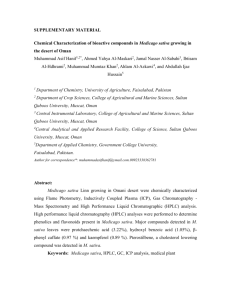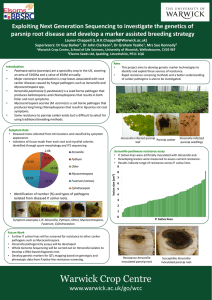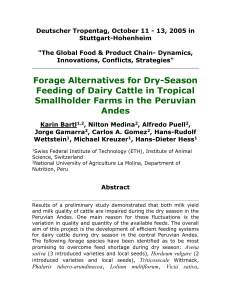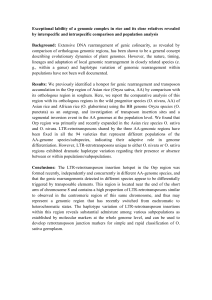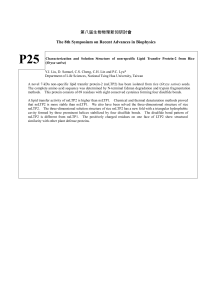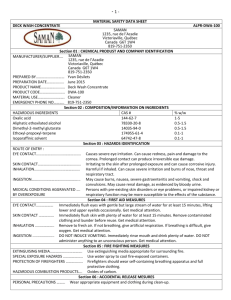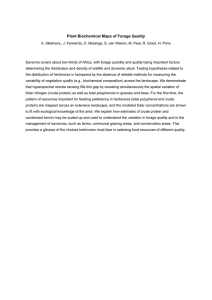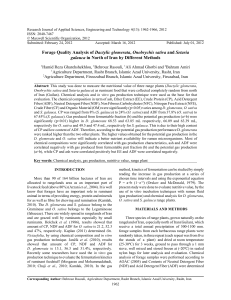International Journal of Animal and Veterinary Advances 4(2): 151-156, 2012
advertisement
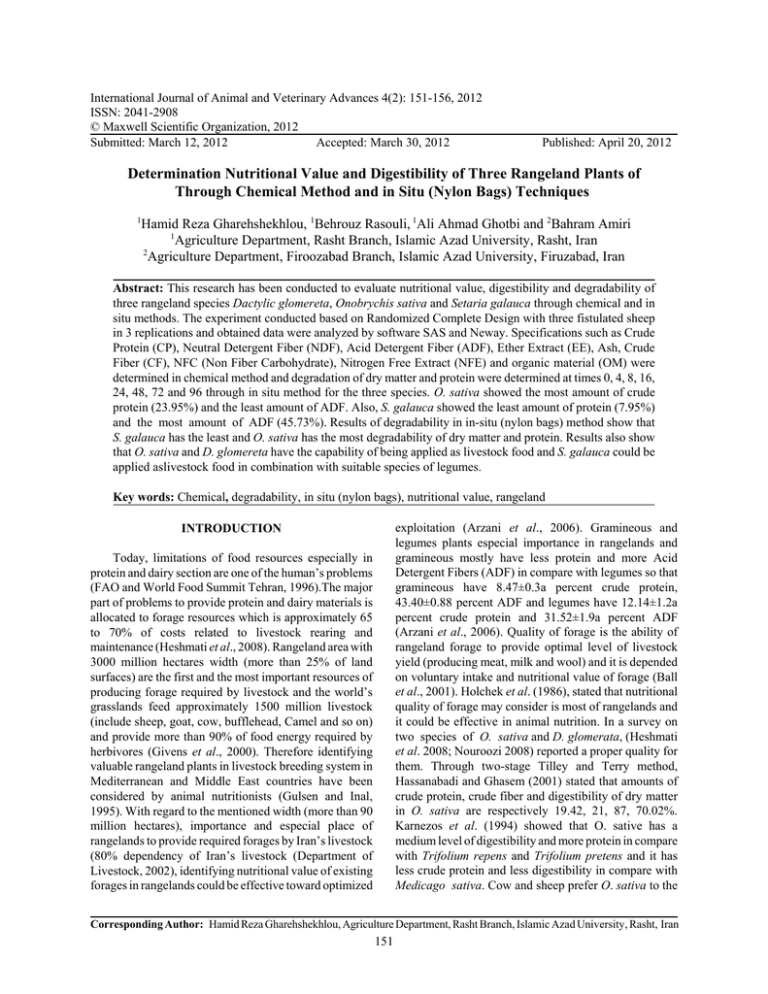
International Journal of Animal and Veterinary Advances 4(2): 151-156, 2012 ISSN: 2041-2908 © Maxwell Scientific Organization, 2012 Submitted: March 12, 2012 Accepted: March 30, 2012 Published: April 20, 2012 Determination Nutritional Value and Digestibility of Three Rangeland Plants of Through Chemical Method and in Situ (Nylon Bags) Techniques 1 Hamid Reza Gharehshekhlou, 1Behrouz Rasouli, 1Ali Ahmad Ghotbi and 2Bahram Amiri 1 Agriculture Department, Rasht Branch, Islamic Azad University, Rasht, Iran 2 Agriculture Department, Firoozabad Branch, Islamic Azad University, Firuzabad, Iran Abstract: This research has been conducted to evaluate nutritional value, digestibility and degradability of three rangeland species Dactylic glomereta, Onobrychis sativa and Setaria galauca through chemical and in situ methods. The experiment conducted based on Randomized Complete Design with three fistulated sheep in 3 replications and obtained data were analyzed by software SAS and Neway. Specifications such as Crude Protein (CP), Neutral Detergent Fiber (NDF), Acid Detergent Fiber (ADF), Ether Extract (EE), Ash, Crude Fiber (CF), NFC (Non Fiber Carbohydrate), Nitrogen Free Extract (NFE) and organic material (OM) were determined in chemical method and degradation of dry matter and protein were determined at times 0, 4, 8, 16, 24, 48, 72 and 96 through in situ method for the three species. O. sativa showed the most amount of crude protein (23.95%) and the least amount of ADF. Also, S. galauca showed the least amount of protein (7.95%) and the most amount of ADF (45.73%). Results of degradability in in-situ (nylon bags) method show that S. galauca has the least and O. sativa has the most degradability of dry matter and protein. Results also show that O. sativa and D. glomereta have the capability of being applied as livestock food and S. galauca could be applied aslivestock food in combination with suitable species of legumes. Key words: Chemical, degradability, in situ (nylon bags), nutritional value, rangeland exploitation (Arzani et al., 2006). Gramineous and legumes plants especial importance in rangelands and gramineous mostly have less protein and more Acid Detergent Fibers (ADF) in compare with legumes so that gramineous have 8.47±0.3a percent crude protein, 43.40±0.88 percent ADF and legumes have 12.14±1.2a percent crude protein and 31.52±1.9a percent ADF (Arzani et al., 2006). Quality of forage is the ability of rangeland forage to provide optimal level of livestock yield (producing meat, milk and wool) and it is depended on voluntary intake and nutritional value of forage (Ball et al., 2001). Holchek et al. (1986), stated that nutritional quality of forage may consider is most of rangelands and it could be effective in animal nutrition. In a survey on two species of O. sativa and D. glomerata, (Heshmati et al. 2008; Nouroozi 2008) reported a proper quality for them. Through two-stage Tilley and Terry method, Hassanabadi and Ghasem (2001) stated that amounts of crude protein, crude fiber and digestibility of dry matter in O. sativa are respectively 19.42, 21, 87, 70.02%. Karnezos et al. (1994) showed that O. sative has a medium level of digestibility and more protein in compare with Trifolium repens and Trifolium pretens and it has less crude protein and less digestibility in compare with Medicago sativa. Cow and sheep prefer O. sativa to the INTRODUCTION Today, limitations of food resources especially in protein and dairy section are one of the human’s problems (FAO and World Food Summit Tehran, 1996).The major part of problems to provide protein and dairy materials is allocated to forage resources which is approximately 65 to 70% of costs related to livestock rearing and maintenance (Heshmati et al., 2008). Rangeland area with 3000 million hectares width (more than 25% of land surfaces) are the first and the most important resources of producing forage required by livestock and the world’s grasslands feed approximately 1500 million livestock (include sheep, goat, cow, bufflehead, Camel and so on) and provide more than 90% of food energy required by herbivores (Givens et al., 2000). Therefore identifying valuable rangeland plants in livestock breeding system in Mediterranean and Middle East countries have been considered by animal nutritionists (Gulsen and Inal, 1995). With regard to the mentioned width (more than 90 million hectares), importance and especial place of rangelands to provide required forages by Iran’s livestock (80% dependency of Iran’s livestock (Department of Livestock, 2002), identifying nutritional value of existing forages in rangelands could be effective toward optimized Corresponding Author: Hamid Reza Gharehshekhlou, Agriculture Department, Rasht Branch, Islamic Azad University, Rasht, Iran 151 Int. J. Anim. Veter. Adv., 4(2): 151-156, 2012 other legumes and cows which are pastured with O. sativa and Digitaria singuinalis showed more daily weight gain in compare with M. sativa (Cash et al., 1993; Koivisto and Lane, 2001). Also regarding in situ technique which foods are put in rumen of animal, the possibility of close proximity with natural environment of fermentation is feasible for foods under study so that despite some deficiencies, it could be say that there is not probably any better method for imitating rumen environment (regarding temperature, acidity, buffer and enzymes) (Taghizadeh, 1996; Minson 1990) stated that in situ technique is proper for gramineous, however, Taghizadeh et al. (2008) it is proper for legumes. Shoorang and NikKhah (2007) reported that in situ technique is suitable for effective digestibility of dry matter, cell wall and cell wall without hemicellulose of rangeland forage and they mentioned that as digestibility is different in various species of rangeland forage, it should be considered in ration and amounts of food consumption in ruminants. To feed livestock correctly with rangeland forages, in addition of having information about chemical compound and nutritious components of forage, awareness of digestibility and using nutrients as more certain criteria for evaluation of forage quality is important too (Arzani, 1994). Therefore, the present research has evaluated nutritional value and digestibility of three rangeland species (D. glomereta, O. sativa and S. galauca) through chemical method and in situ (nylon bags) technique. artificial polyester which are indigestible and resistant against microbial decomposition in rumen with holes of 50 Hm and dimensions 12×18 cm. Head of bags were blocked by string. Times of incubation were 0, 4, 8, 16, 24, 48, 72 and 96 h and 3 replications were provided per hour for each treatment. After times of incubation finished, the bags were out, washed and completely cleared under cold water flow. Then, bags were put in temperature of 65ºC for 24 h. In order to determine its dry matter, they were put in oven with 105ºC for 24 h and percentage of disappeared dry matter and protein computed through following formulas: Disappeared dry matter (%) = Bag’s weight – Sample or bag’s weight after incubation) – ( Bag’s weight – Sample or bag’s weight)×100 Initial weight of food × protein (%) Disappeared protein (%) = (remained protein after incubation (%)×Remained weight after incubation) – (protein (%)×Initial weight of food)×100 Initial weight of food × protein (%) Degradation (%) = (Nutrient after incubation) – (Initial nutrients)×100 Initial nutrient It was computed by software Neway and potential degradation through model P = a+b (1– e-ct) (Orskov and McDonald, 1979): MATERIALS AND METHODS D. glomerata and S. galauca belong to the Gramineae family and O. sativa belongs to the Leguminosae (fabaceae) family. Three species of range plants, grown naturally on the rangeland of Iran, especially north of Iran, which receive a total annual precipitation of 500-1100 mm. this research was done in the Research Institute of Animal Science of Iran (June, 2011). forage samples from each herbaceous range plants were randomly taken, in three repeat (each repeat was from five the stands of a plant) and dried at room temperature (2530ºC) for 3 weeks, ground to pass through a 1 mm sieve, well mixed and stored frozen at (-20ºC) in sealed nylon bags for later analysis and evaluation. Chemical compounds including dry matter, crude protein (Kjeldahl), crude ash (furnace), Fibre (Fibrotic), Ether Extract (Soxhlet extractor) amount of cell wall without hemicellulose (ADF) and cell wall (NDF) determined based on common method of Van Soest et al. (1991) and AOAC (2005). Nylon-bags: Measuring dry matter, protein, cell wall (NDF), cell wall without hemicellulose (ADF) disappeared, were conducted through suggestive method by Orskov and McDonald (1979). In Nylon-bag technique (in situ), 5-10 g samples were put in bags made of P: a: (Disappeared materials(%) in time t) The part which is solved quickly (soluble part in time zero) b: Sample amount is degraded in time t (Degradable potential part) C: Speed of b part’s degradation per hour (fixed rate of degradability along time) 100-(a+b): Percent of total non-degradable material in rumen; e: 2/7182 (log neper) Data obtained from degradability per hour incubation surveyed through SAS software and based on randomized complete design in 3 replications. Statistical model of the design is as: Yij = :+Ti+eij. Yij : Ti eij 152 = = = = Amount per observation Total average Effect of treatment Experimental error Int. J. Anim. Veter. Adv., 4(2): 151-156, 2012 Table 1: Comparison of chemical compounds of species through chemical degradation (based on dry matter) Treatments CP EE CF ASH ADF NDF DMD NFE NFC S. galauca 7.95c 4.06a 31.00a 4.23a 45.67a 73.93a 49.25c 49.7a 38.09a D. glomerata 12.16b 3.47a 28.13b 6.09a 41.81b 72.78b 54.19b 45.24b O. sativa 23.95a 2.51b 12.43c 7.00a 37.78c 53.84c 62.47a 51.16a 29.667b SEM 0.5 0.26 0.81 0.7 1.74 2.16 1.05 0.83 0.89 Sig ** * ** ns ** ** ** * ** ** Columns having different superscripts are significantly different (p< 0.05) TDN 54.93c 35.56a 68.59a .086 ns OM 95.77a 55.71b 93.91a 0.7 93.00a Table 2: Average of dry matter degradability of species over incubation time 96 h in “in situ” technique(percentage of dry matter), characteristics of degradability for nylon bags after 0, 4, 8, 16, 24, 48, 72 and 96 h incubation and effective degradability of dry matter(ED) Incubation time(h)exponential equation Effective degradability ----------------------------------------------------------------------------------------------------------------------------------------------------0 4 8 16 24 48 72 96 a b a+b c K=2% K=5% K=8% D. glomereta 16.8b 24.7b 32.9b 53.2b 61.9a 67.2b 84.9a 81.3a 15.1c 67.9a 83.1a 0.05 61.9 b47.4b 39.8b O. sativa 28.2a 33.5a 51.6a 61.3a 65.1a 75.7a 78.4b 77.9b 26.7a 51.5c 78.2b 0.06 66.1a 55.8a 49.8a S. galauca 18.4b 22.8b 32.9b 37.4c 47.9b 56.8c 65.6c 72.7b 18.8b 57.6b 76.4b 0.03 51.2c 38.6c 33.1c SEM 0.07 1.21 2.62 1.86 1.62 0.73 2.42 0.39 0.39 4.69 2.36 0.01 1.06 1.2 2.14 Sig ** * * ** ** ** * ** ** ** ** ns ** * * a (soluble substances in time 0), b (Fermentable substances) and c (Fixed rate of degradability of part b in time t).Different letters in each column show significant differences. *, ** is significant respectively in levels of 1% and 5%.Passing rate in speeds of K=2%, K=5%, K=8% is respectively for conditions of treatment, fattening and lactation Table 3: Average of protein degradability of species over incubation time 96 h of in situ technique )% dry matter(, characteristics of protein degradability for nylon bags after 0, 4, 8, 16, 24, 48, 72 and 96 h incubation and effective degradability of protein (ED) Incubation time (h)protein(exponential quation)protein (Effective degradability) -----------------------------------------------------------------------------------------------------------------------------------------------------0 4 8 16 24 48 72 96 a b a+b c K=2% K=5% K=8% D. glomereta 25.5b 37.9b 52.4b 63.2b 80.6a 82.6b 93.9a 93.3a 25.2c 67.3a 92.9a 0.06a 75.5b 61.6b 53.8b O. sativa 40.5a 47.7a 64.6a 71.4a 76.61b 90.7a 92.7a 91.4a 40.2a 52.4b 92.6a 0.06a 79.1a 68.3a 62.2a S. galauca 37.4a 47.3a 55.7b 61.7b 69.3c 72.4c 86.4b 86.3b 39.9b 46.9c 86.8b 0.04 a70.6c 60.25b 55.2b SEM 1.68 1.81 2.59 2.15 1.82 0.65 0.88 1.26 2.25 1.31 1.35 0.01 0.57 0.91 0.91 Sig * * * * * ** * * * ** * ns * * ** a (soluble substances in time 0), b (Fermentable substances) and c(Fixed rate of degradability of part b in time t).Different letters in each column show significant differences. *, ** is significant respectively in levels of 1% and 5%.Passing rate in speeds of K = 2%, K = 5%, K = 8% is respectively for conditions of treatment, fattening and lactation. RESULTS D.glomereta 90 80 Percent (%) Results show that species O. sativa and S. galauca have respectively the most and the least crude protein and the least and the most cellulose and hemicellulose structures (Table 1). Average of dry matter disappearance in three species of D. glomereta, O. sativa and S. galauca have statistically significant differences at incubation times (Table 2) and degradation and disappearance of dry matter in all three species are on uptrend over passing time (Fig. 1). Amount of (a) had significant statistical difference among rangeland species (p#0.05). Amount of (a) (insoluble at time 0) for species D. glomereta, O. sativa and S. galauca were respectively 15.04, 26.72 and 18.81% of dry matter. He most and the least coefficient of b (Fermentable material) are respectively belong to O. sativa and D. glomereta (Table 2). Amount of degradability per passing rate at hours K = 2%, K = 5% and K = 8%, respectively for conditions of treatment, fattening and lactation, shows that effective degradability of dry matter in all three species has significant statistical difference and the least and the most amount of it are respectively for O. sativa and S. galauca (Table 2, Fig. 2). S.galauca O.sativa 70 60 50 40 30 20 10 0 0 4 8 16 24 48 Incubation time (h) 72 96 Fig. 1: Degradability of dry matter in the species at incubation time of in situ technique (% dry matter) Most of protein degradability belongs to D. glomereta and its least amount belongs to S. galauca (Table 3). Amount of crude protein disappeared in nylon bag at incubation times is on uptrend (Fig. 3). Degradability coefficient of a (soluble materials at time 0) and b (fermentable materials) in protein of the species under study have significant differences (Table 3). Results of crude protein effective degradability at passing rates 153 Int. J. Anim. Veter. Adv., 4(2): 151-156, 2012 D.glomereta et al., 2009, reported that crude protein in Medicago sativa is 18%. Meyer (2006) and Vasilev et al., 2009 reported that crude protein in Medicago sativa is about 18%. The results show that these species could be replaced in livestock ration. High amount of protein in O. sativa in compare with species D. glomereta and S. galauca is due to higher ratio of leave per stem because leaves of this species are broad leaf and occupy more weight of the plant while more parts of S. galauca are stem and woody parts (Arzani et al., 2006). This mentioned factor is the reason that O. sativa has the least ADF (37%) and S. galauca has the most ADF (45%). Regarding that ADF index shows amount of cellulose and lignin and as these carbohydrates are more existed in plant cells (Arzani et al., 2004), these cells are more observed in tight parts of plant such as stem, therefore, with regard to the higher ratio of stem per leaf in S. galauca in compare with D. glomereta and O. sativa, it has more ADF. Heshmati et al. (2008) also reported that nutritional value of O. sativa is more than D. glomereta which is completely consistent with the conclusions of the present research. These results also are completely consistent with studies conducted by Arzani et al., 2006 and represent high protein and low ADF in legumes in compare with grasses. According to the reports represented by Vasilev et al., 2009 and Meyer (2006) amount of ADF for Medicago sativa are respectively 31 and 32.5. Of course these amounts are approximately equal to amount of ADF in species D. glomereta and O. sativa and amount of ADF in S. galauca is 45% less than this amount. Cellulose and lignin structure in O. sativa and relatively in D. glomereta are similar to Medicago sativa. Holchek et al. (1986) reported that amount of crude protein, NDF and ADF of Medicago sativa are respectively 20.2, 44.4, 35.2% and they are 21.2, 52.3 and 47% in O. sativa, respectively. Ahmadi, 2003, reported an average nutritional value for D. glomereta which is completely consistent with the conclusions of this research. Averages of dry matter disappearance in three species of O. sativa, D. glomereta and S. galauca at incubation times have significant differences. Karnezos et al., 1994, showed that protein and digestibility in O. sativa are more than Trifolium Repens and Trifolium repens and less than Medicago sativa which are not consistent with the results of this research and this study has shown more crude protein and more digestibility in Medicago sativa. Mansouri et al., 2003, reported that dry matter degradability and crude protein of Medicago sativa in insitu technique are respectively 55.9 and 71.87% at hour 96 of incubation while in the present research degradability of all three species was more than Medicago sativa and it is completely consistent with results obtained by kamlak et al. (2005), who reported that dry matter disappearance after 48 hours incubation is 74.6% and 63.3% in Medicago sativa. Hassanabadi and Ghasem (2001) S.galauca O.sativa Passing speed Fig. 2: effective degradability of dry matter of the species D.glomereta S.galauca O.sativa 0 4 8 16 24 48 Incubation time (h) 72 96 Fig. 3: Protein degradability of the species at incubation time of in situ method (% dry matter) D.glomereta S.galauca Percent (%) O.sativa k = 2% k = 5% Incubation time (h) k = 8% Fig. 4: protein effective degradability of the species K = 2%, K = 5% and K = 8% which are, respectively belong to treatment, fattening and lactating conditions show significant statistical differences among the species (Table 3, Fig. 4). DISCUSSION & CONCLUSION Amount of crude protein in O. sativa, D. glomereta and S. galauca are respectively 24, 13 and 8%. Vasilev 154 Int. J. Anim. Veter. Adv., 4(2): 151-156, 2012 reported that crude protein, crude fibers and digestibility of dry matter in Medicago sativa is respectively 19.42, 21.87 and 70.02 and they are 18.32, 28.14 and 76.05 in O. sativa which are consistent with the present research in protein but not in digestibility. According to the obtained results, degradability of O. sativa always has been more than D. glomereta and D. glomereta degradability has been more than S. galauca because species O. sativa is a legume and has more degradability than two other species which are grass (Arzani et al., 2006). Of course after the first 8 hours incubation, degradability has similar speed in both grass species but after this time passed, with regard to cellulose materials remained in S. galauca, degradability speed decreased considerably in this species while as protein existed in D. glomereta, degradability speed increased in it so that after 72 h, it was even more than degradability speed in O. sativa. Considering that cell wall of plant species is degraded at first, therefore, degradability of cell wall has an effective role in degradation of contents and other nutrients because high concentration of cell wall prevents cell wall to be broken and it decreases microbial influence. Also, degradability of protein shows that amount of protein disappearance has been on uptrend and it increases with passing time of incubation in the three species. This phenomenon is justifiable due to changes in population of microorganism in rumen after feeding and effect of food (Najafnejad, 2006). In the first 16 hours of incubation, protein degradability speed in species S. galauca is more than species D. glomereta and it is close to O. sativa. This condition is due to faster degradation of existing protein in S. galauca at the first hours, however this speed decrease in S. galauca after 16 hours but it even increase in O. sativa. Less ADF and more protein in two species of D. glomereta and O. sativa creates such condition. Results of effective degradability shows that in conditions of treatment, fattening and lactating, due to cell structure and more combination of celluloses and lignin in S. galauca than in D. glomereta and cell structure and more combination of celluloses and lignin in D. glomereta than in O. sativa in different passing rates, protein and dry matter effective degradability is more in species O. sativa than D. glomereta and it is more in D. glomereta than S. galauca so that as it could be observed, amount of protein and dry matter degradability is depended on the period when sample is remained in rumen and even passing rate is more, effective degradability decreases due to less compatibility and less effectiveness of microorganisms of rumen (Gosselink et al., 2004). Results of the present research are consistent with this phenomenon and it is also justifiable with it. With regard to results of the three species using chemical method and mentioned objects, it should be said that O. sativa could be at the first level and D. glomereta could be at the second level of replacement possibility in ration of animals to provide their required protein and they could be considered as a self-willed resources with similar protein quality or higher than Medicago sativa so that results obtained by Koivisto and Lane, 2001 showed that O. sativa has similar feed efficiency and digestibility with Medicago sativa for Beef cattle. Of course as these food resources are free, even S. galauca which has 60% of Medicago sativa’s nutritional value is economically optimized and it could be considered in food planning so that Arzani et al. (2006) stated that considering low protein of gramineous such as S. galauca, they could be combined by species of leguminous family for livestock food. REFERENCES Ahmadi, A., 2003. Forage quality of several rangeland species in different levels of phenological growth applying two methods of in vitro and NIR. MS Thesis, University of Tehran, Agricultural Campus. AOAC, 2005. Official Methods of Analysis, AOAC International. 18th Edn., Gaithersburg, USA. Arzani, H., 1994. Some aspects of estimating short term and long term rangeland carrying capacity in the Western Division of New South Wals. Ph.D. Thesis, University of New South Wals, Australia, pp: 308. Arzani, H., M. Basiri, F. Khatibi and G. Ghorbani, 2006. Nutritive value of some zagros mountain rangeland species. Small Rumi. Res., 65: 128-135. Arzani, H., M. Zohdi, E. Fisher, G.H. Zaheddi Amiri, A. Nikkhan and D. Waster, 2004. Phenological effects on forage quality of five grass species. J. Range Manag, 57: 624-630. Ball, D.M., M. Collins, G.D. Lacefield, N.P. Martin, D.A. Mertens, K.E. Olson, D.H. Putnam, D.J. Undersander and M.W. Wolf, 2001. Underestanding Forage Quality, American Farm Bureau Federation Publication 1-01. Park Ridage, IL, pp: 18. Cash, S.D., H. Bowman and R.L. Ditterline, 1993. Sainfoin. Field Crops C-11 (Forage). Department of Livestock, 2002. Ministry of Agriculture. The Estimation of Livestock Population Regarding to Type of Livestock and Province. Fao World Food Summit Tehran, 1996. Economy of Agriculture and Development Journal. 5th year. Special Journal for World Food Summit. pp: 21-30. Givens, D.I., E. Owen, R.F.E. Oxford and H.N. Omed, 2000. Forage Evaluation in Ruminant Nutrition. CABI Publishing, UK, pp: 480. Gosselink, J.M.J., J.P. Dulphy, C. Poncet, S. Tamminga and J.W.A. Cone, 2004. Comparison of in situ and in vitro methods to estimate in vivo fermentableorganic matter of forages in ruminants. NJAS, 52-1: 29-45. Gulsen, N. and F. Inal, 1995. The importance of forage and its problems in Tukey. Turk Veteriner Hekimligi Dergisi, 7: 48-52. 155 Int. J. Anim. Veter. Adv., 4(2): 151-156, 2012 Najafnejad, B., 2006. Study on nutritional value of trifoliumand some concentrated processed materials using in vivo, in vitro, in situ and gas production techniques. MS Thesis, Boo Ali Sina University, Faculty of Agriculture. Nouroozi, A., 2008. Surveying and comparing food combination of leaves and stems of three grass species in rangelands of Lar Dam. The 4th National Conference of Rangeland. pp: 312. Orskov, E.R.I. and I.M. McDonald, 1979. The estimation of protein degradability in the rumen from in rumen from incubation measurements weighted according to rate of passage. J. Agric. Sci. (Cambridge), 92: 499-503. Shoorang, P. and A. NikKhah, 2007. Determining dry matter and cell wall degradability of some rangeland forages through in situ technique and in vitro. Iran Agric. Sci. J., 38(1): 66-57. Taghizadeh, A., V. Palangi and A. Safamehr, 2008. Determining nutritive values of alfalfa cuts using in situ and gas production techniques. Am. J. Anim. Vet. Sci., 3(3) : 85-90. Taghizadeh, A., 1996. Determining digestibility and degradability of some foods through in vivo, in vitro and in situ techniques. MS Thesis, University of Tehran, Agricultural Campus. Van Soest, P.J., J.B. Robertson and B.A. Lewis, 1991. Methods for dietary fiber, neutral detergent fiber and non-starch polysaccharides in relation to animal nutrition. J. Dairy Sci., 74: 3583-3597. Vasilev, E., V. Vasileva, A. Kirilov, M. Nikolova and T. Popp, 2009. The effect of different forms of potash fertilizers on yield and composition of alfalfa and cocksfoot in pure stand and mixture. I. Botanical composition and dry mass yield. Proc. International Symposium on "Nutrient Management and Nutrient Demand of Energy Plants", 06-08 July, Budapest. Hassanabadi, A.M. and J. Ghasem, 2001. Determining Nutritional Values of Some Agricultural and Rangeland Forages in Sistan Region. The 3rd Research Seminar in Livestock and Poultry Feed of Iran, pp: 202. Heshmati, G., M. Baghbani and O. Bazrafshan, 2008. Comparing nutritional value of 11 species in east of Golestan, research and construction. Sci. Res. J. Ministry Constr. Natl. Res., 73: 91-96. Holchek, J.L., H. Wofford, D. Artgun, M.L. Galyean and J.D. Wallace, 1986. Evoluation of total fecal collection for measuring cattle forages. J. Range Manage., 1: 39. Kamlak, A., Canbolanao, Gubruz and O. Ozay, 2005. Comparison of in vitro gas production technique with in situ nylon bag technique to estimate dry matter degradation. Czech. J. Anim. Sci., 50(2): 60-67. Karnezos, T.P., A.G. Matches and C.P. Brown, 1994. Spring lamb production on alfalfa, sainfoin and wheatgrass pastures. Agron. J., 86: 497-502. Koivisto, J.M., G.P.F. Lane, 2001. Sainfoin. Worth Anather Look. Retrieved from: http://www.fao. org/ag/AGP/AGPC/doc/Gbase/AddInfo/sainfoin. pdf. Macdonald, P., R.A. Edwards, G.F.D. Green Hall and C.A. Morgan, 2001. Livestock Feed. Navid Shad Bahman, J.S. Alireza, (Eds.), Haghshenas Publication, Rasht, Iran. Mansouri, H., E. NikKhah, M. Rezaeian, A. Mir Hadi, 2003. Determining forage degradability using gas production and in situ technique. Iran Agric. Sci. J., 34(2): 495-507. Meyer, R., 2006. Potassium Fertilization and How It Effects Yield and Quality of Alfalfa. Proc. California Plant and Soil Conference Realities of Modern Agriculture, pp: 127-133. Minson, D.J., 1990. Forage in Ruminant Nutrition. Academic Press Inc., San diego, California, pp: 250. 156
